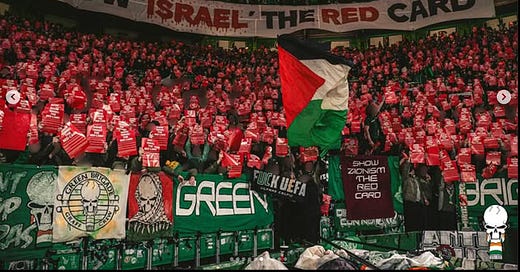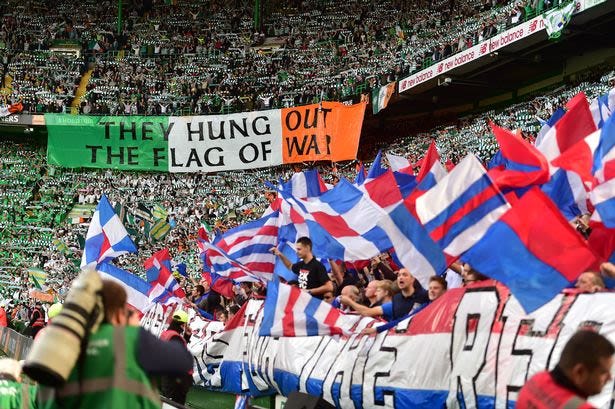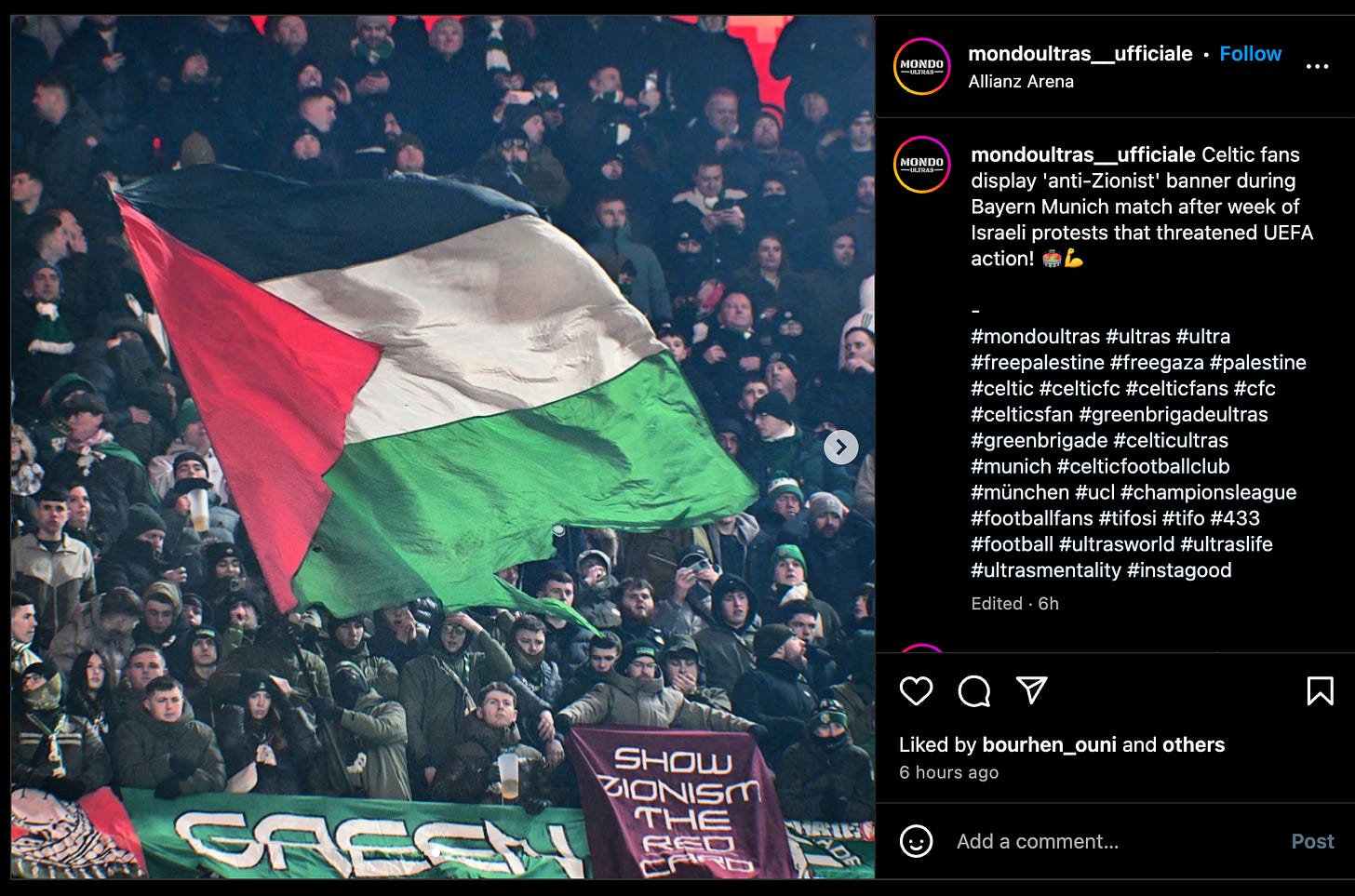Why Do Celtic's fans support Palestine?
In the last two Champions League matches against Bayern Munich, Celtic's fans have expressed their dissent against Israel
Glasgow, 12th February 2025.
At Celtic Park, Celtic takes on Bayern Munich in the first leg of the Champions League playoffs.
In the stands, a huge banner appears, reading:
"Show Israel the red card."
Source: Green Brigade Instagram Account
It is not the first time, and certainly will not be the last, that Celtic fans show their support for the Palestinian cause at Celtic Park. The same thing happened on November 22, 2023, during a Champions League match, but that time against Atlético Madrid.
That night, fans waved Palestinian flags and displayed several banners. UEFA fined the club $19,000. The banners were described as "provocative messages of an offensive nature."
For the fans, it was a demonstration of support for the people of Gaza. It had been only a short time since Hamas’ attack on October 7 and Israel’s immediate response.
More than a year has passed since those tragic events. In the meantime, there has been a ceasefire, Trump is once again President of the United States, and his statements about the future of the Gaza Strip have sparked significant controversy. Amid all this, nothing has changed at Celtic Park.
If an unsuspecting football fan had attended the match against the Bavarians, she/he would have had every reason to wonder why the supporters of a Scottish team feel the need to show such strong support for a population living more than 4,000 kilometres away—one with whom, theoretically, they share nothing.
We must journey through the club's history to understand the Celtic fans' support for the Palestinian cause.
Irish is not British
Before talking about football, a brief history lesson is necessary.
It is important to know that Ireland was England’s first colony, and the Irish lived under English and British domination for over 700 years.
British control over the island began in the 13th century. For centuries, the Irish people were victims of colonization. The island has always been home to the Irish, divided between Catholics and Protestants—the former primarily in the south and northwest, the latter in the northeast.
The situation began to change in 1919 when the Sinn Féin party declared the establishment of an Irish Republic. This event led to the Irish War of Independence (1919–1921). After the conflict, Catholics founded the Republic of Ireland, while the six counties of Northern Ireland, mostly inhabited by Protestants, remained part of the United Kingdom.
Ireland gained independence as the Irish Free State only in 1922. In 1937, the new Irish constitution officially named the nation Éire, and in 1949, the Republic of Ireland left the British Commonwealth.
Today, the island of Ireland consists of two states:
the Republic of Ireland, an independent country and a member of the European Union
Northern Ireland, which is part of the United Kingdom.
Nevertheless, the Irish question remains unsolved. In the six counties that make up Northern Ireland, Protestants and Catholics have lived in a complex and tense coexistence for years. This tension gave rise to a thirty-year conflict (1968–1998) known as The Troubles. It was a sectarian conflict that caused many casualties and represented a major issue for London. Only in 1998, with the Good Friday Agreement, did the violence cease.
Brexit, however, has reignited old tensions. The United Kingdom’s departure from the European Union raised the spectre of a physical border between Ireland and Northern Ireland. Aware of the potential consequences, British lawmakers ensured that a border was not reestablished between the two states. The solution was to keep the border open between the Republic of Ireland and Northern Ireland but to place a new one in the waters separating Northern Ireland from Great Britain.
This solution seems to be working. But even before Brexit and ‘The Troubles’, there was one particularly defining moment in British-Irish relations: the Great Famine, or Gorta Mór in Irish.
The most tragic event the Irish experienced under British rule.
The consequences were disastrous. It is estimated that 1 million people died. Before the famine, Ireland’s population was 8.5 million. By 1901—just over 50 years after the famine began—only 4.4 million Irish were left.
This tragedy was also exacerbated by discriminatory policies imposed by the British against the Irish population. The Irish were not allowed to obtain fishing or hunting licenses, and much of the food produced in Ireland was exported to England.
The situation worsened with the spread of Phytophthora infestans, which devastated potato crops. Beyond the many who died, millions of Irish emigrated worldwide to survive—some settling in Glasgow.
Irish Immigration
And it is precisely in Glasgow that this story begins.
Once in the Scottish capital, the Irish faced discrimination simply for being Catholic—a characteristic that distinguished them from the Protestant local Scots.
Moreover, Irish immigrants lived in extreme poverty, were confined to ghettos, and were constantly marginalized by Scottish society.
It was precisely to help these people that Celtic was founded. The goal was to raise funds through the football club and use the money to support poor Irish families.
Although 137 years have passed since the club's founding, its connection to the Republic of Ireland remains strong. And Celtic fans express this identity powerfully, especially during what has been dubbed ‘The Hate Game’, better known as ‘The Old Firm’, where Celtic faces their city rivals, Rangers.
During those 90 minutes, it’s much more than football. The match reflects the deep-rooted identities of both sides: Irish Catholic nationalism on one side and Protestant unionism on the other.
Beyond preserving Irish identity, Celtic fans also support several social and political causes. In recent years, one of these has put them under the spotlight: support for the Palestinian cause.
It is common to hear a Celtic fan use the word genocide to describe both what the Irish suffered under British rule and what the Palestinians are experiencing at the hands of Israel.
For those who support the Palestinian cause, the connection between these two peoples is based on shared suffering.
Among the supporters of Palestine, one ultra group has stood out more than any other.
The Green Brigade
Formed in 2006, the Green Brigade is an ultra group known for its support of Irish republicanism and the Palestinian cause. Their activities go far beyond cheering for their beloved team.
In the past, it was common to see members of the group displaying shirts, banners, and chants in support of the IRA (Irish Republican Army). The Irish paramilitary organization that fought for Ireland’s independence from the United Kingdom and the reunification of Northern Ireland with the Republic of Ireland. After the Good Friday Agreement, the IRA declared its ceasefire.
The Green Brigade has also made headlines for its protests against the United Kingdom and the monarchy—especially during Remembrance Day (November 11), when teams in the UK wear red poppies to commemorate British and Commonwealth soldiers who died in war.
They also expressed their disdain for the monarchy following the death of Queen Elizabeth II, displaying a banner that read “F*** the Crown.”
And they have been behind the organization of the banners and Palestinian flags displayed in recent years at Celtic Park.
Much More Than Football
One must not make the mistake of assuming that the Green Brigade represents the sentiments of all Celtic fans. There are sections of the stadium that disagree with them—or fans who attend matches to just enjoy the game.
The club has had to pay fines due to the ultras’ actions and has taken strong measures against them, even banning them from the stadium.
But nothing seems to deter the Green Brigade.
On Tuesday night, Celtic played in Munich for the second leg of the playoff.
Celtic scored the goal that levelled the aggregate score (Bayern had won 2-1 in the first leg), and the Bavarians secured qualification only with a last-minute goal from Davies.
Source: Mondoultras Instagram account
But once again, in the stands, the Celtic supporters achieved their goal.
Even in Munich, they showed their support for the Palestinian cause by displaying a banner against Israel.
When Celtic plays, it’s always much more than football.
Sources:
https://www.nytimes.com/athletic/4988876/2023/10/26/celtic-palestinian-flags/
https://www.bbc.com/sport/football/articles/c30dedle3zno







Good history although think mentioning that a big part of the conflict is protestants emerged in Ireland out of the milieu of Scottish soldiers who settled in the north after the wars of conquest which is another parallel with Palestine in the eyes of some
Love it